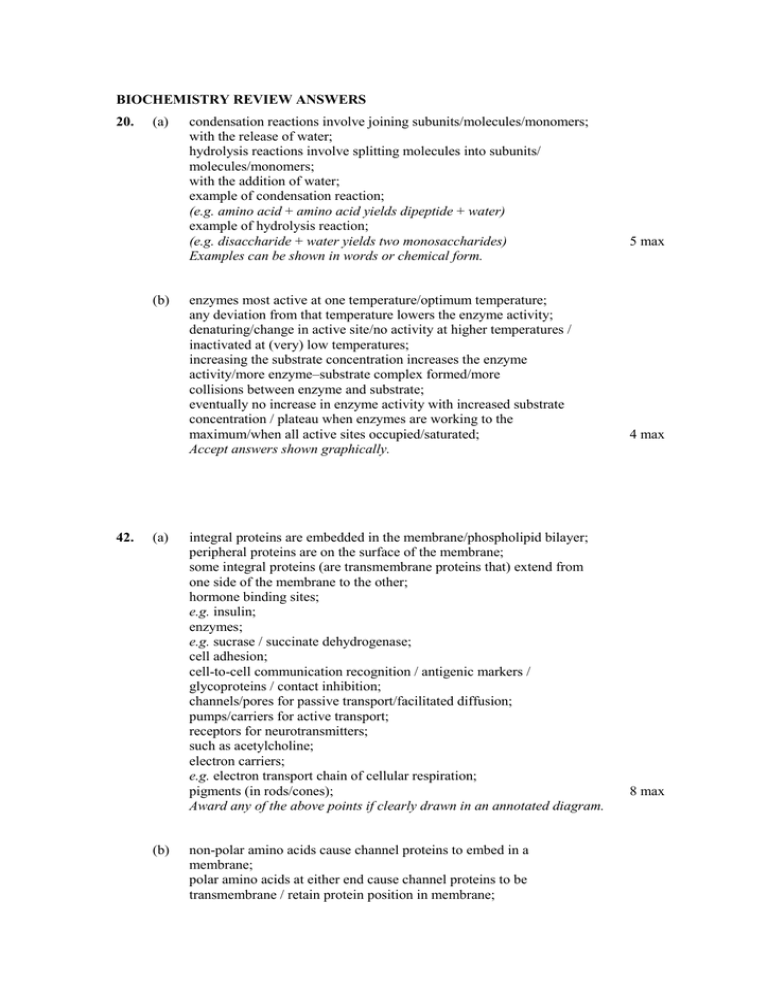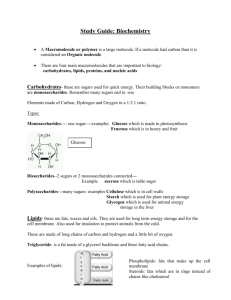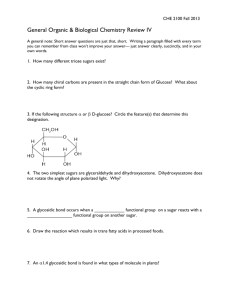BIOCHEMISTRY REVIEW ANSWERS 20. (a) condensation
advertisement

BIOCHEMISTRY REVIEW ANSWERS 20. (a) (b) 42. (a) (b) condensation reactions involve joining subunits/molecules/monomers; with the release of water; hydrolysis reactions involve splitting molecules into subunits/ molecules/monomers; with the addition of water; example of condensation reaction; (e.g. amino acid + amino acid yields dipeptide + water) example of hydrolysis reaction; (e.g. disaccharide + water yields two monosaccharides) Examples can be shown in words or chemical form. enzymes most active at one temperature/optimum temperature; any deviation from that temperature lowers the enzyme activity; denaturing/change in active site/no activity at higher temperatures / inactivated at (very) low temperatures; increasing the substrate concentration increases the enzyme activity/more enzyme–substrate complex formed/more collisions between enzyme and substrate; eventually no increase in enzyme activity with increased substrate concentration / plateau when enzymes are working to the maximum/when all active sites occupied/saturated; Accept answers shown graphically. integral proteins are embedded in the membrane/phospholipid bilayer; peripheral proteins are on the surface of the membrane; some integral proteins (are transmembrane proteins that) extend from one side of the membrane to the other; hormone binding sites; e.g. insulin; enzymes; e.g. sucrase / succinate dehydrogenase; cell adhesion; cell-to-cell communication recognition / antigenic markers / glycoproteins / contact inhibition; channels/pores for passive transport/facilitated diffusion; pumps/carriers for active transport; receptors for neurotransmitters; such as acetylcholine; electron carriers; e.g. electron transport chain of cellular respiration; pigments (in rods/cones); Award any of the above points if clearly drawn in an annotated diagram. non-polar amino acids cause channel proteins to embed in a membrane; polar amino acids at either end cause channel proteins to be transmembrane / retain protein position in membrane; 5 max 4 max 8 max polar amino acids lining pore allow polar particles to pass through/ form hydrophilic channels through membranes; polar amino acids on surface of enzyme allow it to dissolve in water; polar and non-polar amino acids contribute to the specificity of an enzyme; non-polar amino acids of surface of enzyme allow it to embed in a membrane; polar amino acids at active site of enzyme attract polar substrates; positively charged amino acids attract negatively charged substrate / vice versa; non-polar amino acids at active site attract non-polar substrate; Award any of the above points if clearly drawn in an annotated diagram. 5 max 59. (a) fructose/ribose/deoxyribose/ribulose/other monosaccharides apart from glucose and galactose 1 (b) (i) disaccharide 1 (ii) hydrolysis 1 (c) (d) it allows people who are lactose intolerant/have difficulty digesting lactose to consume milk (products); galactose and glucose taste sweeter than lactose reducing need for additional sweetener (in flavoured milk products); galactose and glucose are more soluble than lactose / gives smoother texture / reduces crystalization in ice cream; (bacteria) ferment glucose and galactose more rapidly (than lactose) shortening production time (of yogurt/cottage cheese); 3 max less denaturation / enzymes last longer at lower temperatures; lower energy costs / less energy to achieve 5°C compared to 48°C; reduces bacterial growth / reduces (milk) spoilage; to form products more slowly / to control rate of reaction; 2 max [8] 64. (a) (b) monosaccharides are single sugars and disaccharides are two sugars and polysaccharides are multiple sugars; hydrolysis is the addition of water to split a molecule into smaller fragments; –OH and –H are added to the fragments; disaccharides are split/digested into two single sugars; polysaccharides are broken/digested into smaller fragments (e.g. disaccharides); process depends on enzyme control (in organisms); a particular yeast (growing in natural milk) contains lactase; biotechnology companies can grow/culture the yeast; 4 max (c) lactase (an enzyme) is extracted from the yeast; natural milk contains lactose/milk sugar; when added directly to milk, lactase converts lactose into simpler forms; same effect when milk is passed past immobilized (on surface or beads) lactase; simpler forms of sugar (glucose and galactose) are easily absorbed (in the small intestine); a commercial market exists for lactose-free milk / lactose-free milk is example of biotechnology’s economic impact; some people are lactose intolerant/cannot digest lactose in milk/have lost lactase activity in intestinal cells; consuming lactose-free milk allows lactose intolerant people to be nourished by milk without discomfort (abdominal cramps and diarrhoea); many Asians are lactose intolerant whereas less common among other groups (northern Europeans and some Africans); biotechnology produced in one part of world is more useful in another; 6 max food must be in a small enough form to leave the gut and enter the bloodstream; physical breakdown is not enough / chemical breakdown is necessary; enzymes are required for the chemical breakdown of food; enzymes increase the rate of digestion; enzymes are biological catalysts; enzymes allow digestion to occur at body temperature; enzymatic digestion is a sequential process e.g. from protein to peptide to amino acid; specific location for each reaction with specific conditions/environments e.g. stomach high acidity; most enzymes work extracellularly / some enzymes work intracellularly; variations in pH throughout digestive tract promote the activity of different digestive enzymes / different enzymes have different optimal pHs; amylases digest carbohydrate to monosaccharides; proteases digest proteins to amino acids; lipases digest fats to fatty acids and glycerol; 8 max (Plus up to [2] for quality)






